It won’t take more than a minute in the saddle to know BMW has comprehensively changed and dramatically improved the stalwart R1200RT, a long-distance runner that the company claims is the “travel-tourer” sweet spot of its model line. Where BMW salesmen are happy to sell you the F1-racer-esque, six-cylinder K1600GT or GTL and might even usher you over to a GS when you say you want to cover long distances in comfort and luxury, they really should spin you around and point you at the RT.
Relieve yourself of the notion that the RT is another of BMW's legacy "old man" machines, a throwback to the day when the GS was a clanky air-cooled (if still groundbreaking) plonker and the hottest bike in the line made 100 hp. This is not that BMW, and the latest RT is not that RT, either.
Obviously, the news here is the wasserboxer engine, shared with the Motorcycle of the Year R1200GS and the newly released R1200GS Adventure. While the iterations of BMW's large, air/oil-cooled boxer have been many, and the latest provided a surprisingly healthy 110 hp at the crank, the new powerplant is a stunner, built to ameliorate all the traditional issues of this design and pumped up with a satisfyingly usable 125 hp.
You can't tell that as you throw a leg over the RT's beautifully sculpted (and heated) seat, but what you do notice is less. If your last encounter with a BMW tourer was the K1600, the RT will feel almost miniature, the gorgeous instrument panel compact and close and the heated handgrips a reasonable reach. The company gave the RT an entirely new chassis, shared in concept with the GS and featuring steel tubes all the way from the swingarm pivot to the steering head. As such, the engine is a semi-stress-bearing member; it's solidly tied to the frame but doesn't carry all the loads. In this remake, BMW lowered the entire bike by 0.8 inch without reducing suspension travel. What's more, because the new engine is slimmer where the gearbox used to be, the frame could be narrow at the footpegs as well, meaning that lowering the RT does not reduce cornering clearance. In fact, it has more than before. Finally, the dropped stance, along with a standard two-position rider seat and an accessory low seat means a suspension-lowering option is no longer needed. One bike fits all.
All of those alterations make for a "right sized" touring machine that feels totally to human scale. The ergonomic layout is a perfect compromise of semi-sporty aggression and long-range, spread-out room. Huge props to the aerodynamicists who tweaked the new fairing, whose K16-look headlight unfortunately doesn't include the "seeing into corners" pivoting reflector; though the large low beam and twin highs are plenty bright. Settle into the seat, tweak the electrically adjustable windscreen for your height, and it's possible to achieve a still-air pocket so effective you can hear gear whine and tread moan over the wind. Your first thought: "I could ride this bike all freakin' day."
If you're smart, you'll find some twisty pavement before hitting the highway. Here, the RT continues to show newfound poise and, believe it or not, surprising aggression. This new engine grumbles and growls under acceleration, pulling with real vigor to the 9,000-rpm redline. While the 646-pound wet weight keeps raw performance to something less than heart-pounding, the RT never feels like it needs more grunt or extra gears, whether you're climbing a mountain road or overtaking a line of semis. For the RT (and the new GS Adventure), BMW gave the 1,170cc engine an additional 2 pounds of crankshaft mass, equating to a 20-percent increase in crank inertia. This change smooths power delivery—aided by absolutely spot-on ride-by-wire engine management—without making the Boxer feel dull.
Good thing the updated chassis is a match for the powerplant. Riding on a surprisingly short 58.5-inch wheelbase, the RT has reflexes you don't expect from a touring rig. Steering is very light, yet the bars accurately telegraph what the front tire is doing. BMW has gradually improved feedback from its unique Telelever front end, and this one's a winner.
You expect TC and linked ABS on an RT-class machine, and for this year you also get BMW's Dynamic ESA, three ride modes, and—sit down while you read this—a quickshifter that works both up and down, called Gear Shift Assist Pro. BMW has adapted a version of its D-ESA for the RT, which includes wheel-position sensors, dynamically adjusting damping, and electrically operated spring preload for the rear shock. Three basic damping settings—Soft, Normal, and Hard—join with three load settings to create a ride that can be cautiously sporty or utterly creamy, depending on which mode you choose. Still, this is a touring bike, and BMW's definition of "hard" here is what most of us call normal; even so, the chassis displays minimal pitching and retains enough cornering clearance to have a passenger white-knuckling the grab rails. Brake deep into corners, tilt the horizon, and grab a handful on the way out. You can treat the RT much more like an S1000R than you'd ever imagine. Seriously. We mean it.
You might not want to pretend the quickshifter works like your S1000R's, though. The concept is sound, and the idea that the RBW will blip the throttle to match revs on the downshift is cool, but the engine and driveline have too much inertia for the first couple of gears. You get a lot of head toss unless you find just the right technique to pull it off. On hard downshifts at speed and during full-throttle, top-of-the-tach upshifts—and from gears three through six—it's all good. More effective is BMW's Hill-Start Control. Squeeze the front brake firmly while stopped and the system puts on the rear brake, keeping the bike from moving. As soon as the various ECUs sense forward motion, the brake releases.
We've leveled barely any complaints at the RT, and that's partly because there are so few. True, the silver upper triple clamp and handlebars cast annoying reflections onto the multifunction display, and it's also true there is some buzzing in the bars at 90-plus-mph cruising speeds. But even at a brisk pace, the RT averaged 43 mpg, good for 250-plus-mile range.
And while the RT with the Premium package is priced at the same $20,850 as last year's model, that's nearly $2,000 above the Triumph Trophy SE and clear of most Japanese STs. Our tester was "fully loaded" at $21,700, which includes central locking, the Gear Shift Assist Pro, and an alarm. The K16-style saddlebags are standard, but a top box is optional. So the BMW sits at the top of the class price-wise, but it's also the best equipped—including a standard, Bluetooth-enabled audio system with satellite radio and prep for BMW's GPS—and arguably the most sophisticated. That much we expected. The new RT's light-footed vigor and willingness to have fun? A delightful surprise.
Editor at Large | AGE: 39 | HEIGHT: 5'7" | WEIGHT: 155 lb. | INSEAM: 31 in.
The RT abbreviation officially designates reise tourer ("travel tourer"), though in this latest rendition, it could just as well signify "ridiculously transparent." Blitzing over Palomar Mountain and watching Cook's well-ridden FJR1300ES shrink in the mirrors, I could think of few bikes more confidence inspiring than this one. BMW's proprietary suspension systems—aided immensely here by electronically assisted Dynamic ESA that always delivers exactly the right suspension response—are nearly immune to braking or accelerating influence, so steering remains neutral and consistent regardless of speed or lean angle. Add broadly accessible power and unfailing rider aids and you've got a bike that effectively manages itself, leaving you much more mental bandwidth to concentrate on your ride—whether that's winding over a mountain grade or inhaling highway miles at warp speed. No, $21,700 is not cheap—but it's a small price to pay to make your motorcycle disappear completely.
A wholly new machine with a familiar label, borrowing heav-ily from the MOTY-winning R1200GS.
Aprilia Caponord, Honda ST1300, Kawasaki Concours 14, Moto Guzzi Norge, Triumph Trophy SE, Yamaha FJR1300
Verdict: Tremendously competent, feature filled, quick enough to please, comfortable enough for all week, not just all day.
What more can you ask for in a real-world, roadgoing opposed twin? BMW's latest Boxer belts out excellent torque with superb manners. Besides the slight sag at 3,000 rpm, it keeps the torque above 70 pound-feet for most of its useful rev range. The rise to peak horsepower is steady. These are the kinds of power curves you see in engine-design textbooks. It's much the same good news on the ergonomic front: BMW gave the RT a moderately upright riding position with generous legroom (with the seat in the higher position). It's a bit more sit-up than a Yamaha FJR1300, but what you can't see here is how much slimmer the RT is between your heels.










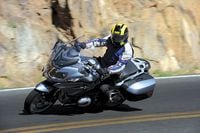
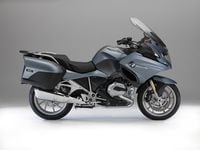

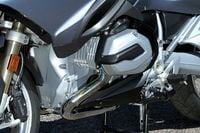

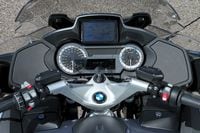
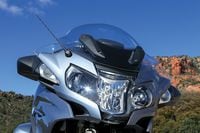

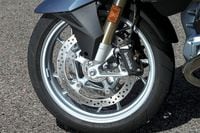


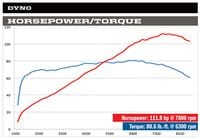

/cloudfront-us-east-1.images.arcpublishing.com/octane/S35YGSEMEZB4BLTDJTSZPF4GLA.jpg)
/cloudfront-us-east-1.images.arcpublishing.com/octane/5UOT6HPX2JFMRJAX6EH45AR4MQ.jpg)
/cloudfront-us-east-1.images.arcpublishing.com/octane/OKWOJWAKP5EP3OACCRRWPCIX2Q.jpg)
/cloudfront-us-east-1.images.arcpublishing.com/octane/2WF3SCE3NFBQXLDNJM7KMXA45E.jpg)
/cloudfront-us-east-1.images.arcpublishing.com/octane/G4MG6OUCJNBSHIS2MVVOTPX65E.jpg)
/cloudfront-us-east-1.images.arcpublishing.com/octane/IIGGWFOTOJGB7DB6DGBXCCMTDY.jpg)
/cloudfront-us-east-1.images.arcpublishing.com/octane/QSTCM6AVEZA5JJBUXNIQ3DSOF4.jpg)
/cloudfront-us-east-1.images.arcpublishing.com/octane/U4I7G625B5DMLF2DVIJDFZVV6M.jpg)
/cloudfront-us-east-1.images.arcpublishing.com/octane/B6XD6LS6IVCQPIU6HXDJSM3FHY.jpg)
/cloudfront-us-east-1.images.arcpublishing.com/octane/ICL63FEDDRDTTMINYICCEYGMDA.jpg)
/cloudfront-us-east-1.images.arcpublishing.com/octane/FCGZHQXRBZFLBAPC5SDIQLVF4I.jpg)
/cloudfront-us-east-1.images.arcpublishing.com/octane/WNOB6LDOIFFHJKPSVIWDYUGOPM.jpg)

/cloudfront-us-east-1.images.arcpublishing.com/octane/X33NU3E525ECRHXLNUJN2FTRKI.jpg)
/cloudfront-us-east-1.images.arcpublishing.com/octane/6KKT5NNL2JAVBOXMZYS5ZO76YA.jpg)
/cloudfront-us-east-1.images.arcpublishing.com/octane/J5RKG5O455GMPGQRF2OG6LRT7A.jpg)
/cloudfront-us-east-1.images.arcpublishing.com/octane/GX2CIZKQVRH2TATDM26KFG2DAE.jpg)
/cloudfront-us-east-1.images.arcpublishing.com/octane/ZWIDYSAKQZHD5BHREMQILXJCGM.jpg)
/cloudfront-us-east-1.images.arcpublishing.com/octane/CYUHJZCTSJCH3MRAQEIKXK7SCQ.jpg)
/cloudfront-us-east-1.images.arcpublishing.com/octane/LKOFINY56FCXJCANJ5M7ZDQUBY.jpg)
/cloudfront-us-east-1.images.arcpublishing.com/octane/4NBPDACMWJH63JQYJVK3QRBDZI.jpg)
/cloudfront-us-east-1.images.arcpublishing.com/octane/KKHQHRR3FJGX7H2IPU6RALMWG4.jpg)

/cloudfront-us-east-1.images.arcpublishing.com/octane/5IOFS5JAE5FOXMNA23ZRAVVYUU.jpg)